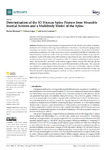Mostrar o rexistro simple do ítem
Determination of the 3D Human Spine Posture from Wearable Inertial Sensors and a Multibody Model of the Spine
| dc.contributor.author | Michaud, Florian | |
| dc.contributor.author | Lugrís-Armesto, Urbano | |
| dc.contributor.author | Cuadrado, Javier | |
| dc.date.accessioned | 2022-07-12T10:26:33Z | |
| dc.date.available | 2022-07-12T10:26:33Z | |
| dc.date.issued | 2022 | |
| dc.identifier.citation | Michaud, F.; Lugrís, U.; Cuadrado, J. Determination of the 3D Human Spine Posture from Wearable Inertial Sensors and a Multibody Model of the Spine. Sensors 2022, 22, 4796. https://doi.org/10.3390/s22134796 | es_ES |
| dc.identifier.issn | 1424-8220 | |
| dc.identifier.uri | http://hdl.handle.net/2183/31165 | |
| dc.description.abstract | [Abstract] Determination of spine posture is of great interest for the effective prevention, evaluation, treatment and evolution monitoring of spinal disorders. Limitations of traditional imaging systems, including cost, radiation exposure (for X-ray based systems), projection volume issues and subject positioning requirements, etc., make non-invasive motion assessment tools effective alternatives for clinical and non-clinical use. In this work, a procedure was developed to obtain a subject-specific multibody model of the spine using either inertial or optical sensors and, based on this multibody model, to estimate the locations and orientations of the 17 vertebrae constituting the thoracolumbar spine. The number and calibration of the sensors, angular offsets, scaling difficulties and gender differences were addressed to achieve an accurate 3D-representation of the spine. The approach was validated by comparing the estimated positions of the sensors on 14 healthy subjects with those provided by an optical motion capture system. A mean position error of lower than 12 mm was obtained, thus showing that the proposed method can offer an effective non-invasive tool for the assessment of spine posture. | es_ES |
| dc.description.sponsorship | This work was funded by the Spanish MCI under project PGC2018-095145-B-I00, co-financed by the EU through the EFRD program, and by the Galician Government under grant ED431C2019/29 and under grant IN853B-2018/02 | es_ES |
| dc.description.sponsorship | Xunta de Galicia; ED431C2019/29 | es_ES |
| dc.description.sponsorship | Xunta de Galicia; IN853B-2018/02 | es_ES |
| dc.language.iso | eng | es_ES |
| dc.publisher | MDPI | es_ES |
| dc.relation | info:eu-repo/grantAgreement/AEI/Plan Estatal de Investigación Científica y Técnica y de Innovación 2017-2020/PGC2018-095145-B-I00/ES/ESTUDIO DE LA RELACION ENTRE EFICIENCIA Y NIVEL DE DETALLE EN MODELOS BIOMECANICOS DEL CUERPO HUMANO/ | |
| dc.relation.uri | https://doi.org/10.3390/s22134796 | es_ES |
| dc.rights | Attribution 4.0 International (CC BY 4.0) | es_ES |
| dc.rights.uri | https://creativecommons.org/licenses/by/4.0/ | * |
| dc.subject | Spinal disorders | es_ES |
| dc.subject | Injury prevention | es_ES |
| dc.subject | Motion capture | es_ES |
| dc.subject | Inertial sensor | es_ES |
| dc.title | Determination of the 3D Human Spine Posture from Wearable Inertial Sensors and a Multibody Model of the Spine | es_ES |
| dc.type | info:eu-repo/semantics/article | es_ES |
| dc.rights.access | info:eu-repo/semantics/openAccess | es_ES |
| UDC.journalTitle | Sensors | es_ES |
| UDC.volume | 22 | es_ES |
| UDC.issue | 13 | es_ES |
| UDC.startPage | 1 | es_ES |
| UDC.endPage | 12 | es_ES |
| dc.identifier.doi | 10.3390/s22134796 |
Ficheiros no ítem
Este ítem aparece na(s) seguinte(s) colección(s)
-
LIM - Artigos [51]






